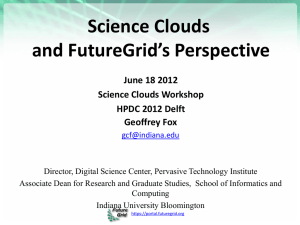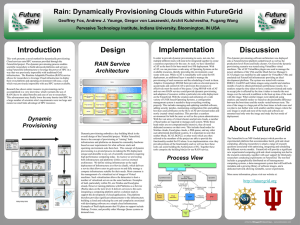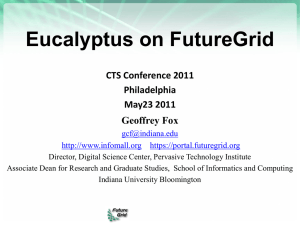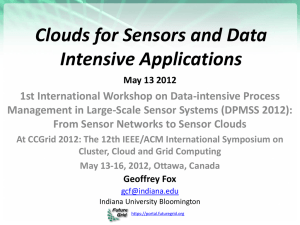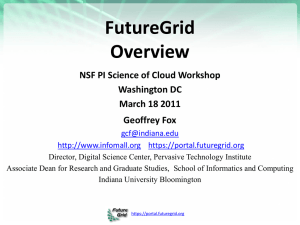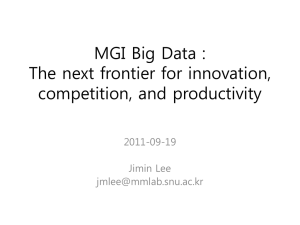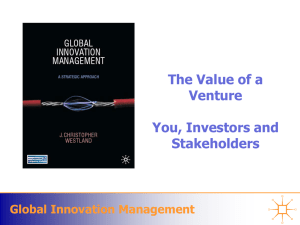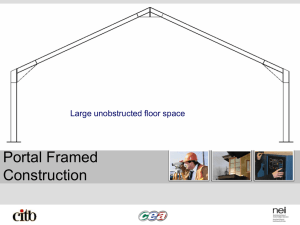iupui-feb11-2011 - Community Grids Lab
advertisement
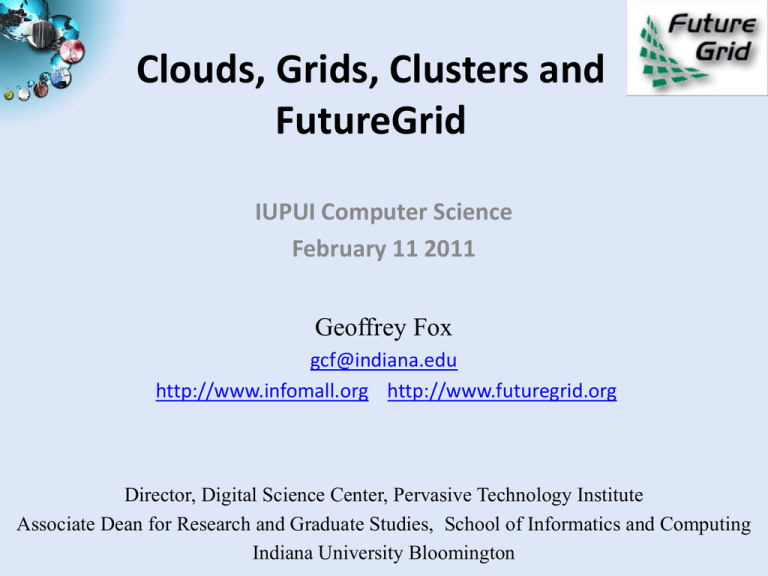
Clouds, Grids, Clusters and FutureGrid IUPUI Computer Science February 11 2011 Geoffrey Fox gcf@indiana.edu http://www.infomall.org http://www.futuregrid.org Director, Digital Science Center, Pervasive Technology Institute Associate Dean for Research and Graduate Studies, School of Informatics and Computing Indiana University Bloomington Abstract • We analyze the different tradeoffs and goals of Grid, Cloud and parallel (cluster/supercomputer) computing. • They tradeoff performance, fault tolerance, ease of use (elasticity), cost, interoperability. • Different application classes (characteristics) fit different architectures and we describe a hybrid model with Grids for data, traditional supercomputers for large scale simulations and clouds for broad based "capacity computing" including many data intensive problems. • We discuss the impressive features of cloud computing platforms and compare MapReduce and MPI where we take most of our examples from the life science area. • We conclude with a description of FutureGrid -- a TeraGrid system for prototyping new middleware and applications. Important Trends • Data Deluge in all fields of science • Multicore implies parallel computing important again – Performance from extra cores – not extra clock speed – GPU enhanced systems can give big power boost • Clouds – new commercially supported data center model replacing compute grids (and your general purpose computer center) • Light weight clients: Sensors, Smartphones and tablets accessing and supported by backend services in cloud • Commercial efforts moving much faster than academia in both innovation and deployment Cloud Computing Transformational Cloud Web Platforms Media Tablet High Moderate Low Gartner 2009 Hype Curve Clouds, Web2.0 Service Oriented Architectures Data Centers Clouds & Economies of Scale I Range in size from “edge” facilities to megascale. Economies of scale Approximate costs for a small size center (1K servers) and a larger, 50K server center. 2 Google warehouses of computers on Technology in smallCost in Large Ratio the banks ofCost the sized Data Columbia Data Center River, in The Dalles, Center Oregon Network $95 per Mbps/ $13 per Mbps/ 7.1 Such centers use 20MW-200MW month month Storage $2.20 per GB/ 150 $0.40 per GB/ 5.7 CPU (Future) each with watts per month month Save money~140from large size, 7.1 Administration servers/ >1000 Servers/ Administrator positioning Administrator with cheap power and access with Internet Each data center is 11.5 times the size of a football field Data Centers, Clouds & Economies of Scale II • Builds giant data centers with 100,000’s of computers; ~ 200-1000 to a shipping container with Internet access • “Microsoft will cram between 150 and 220 shipping containers filled with data center gear into a new 500,000 square foot Chicago facility. This move marks the most significant, public use of the shipping container systems popularized by the likes of Sun Microsystems and Rackable Systems to date.” 6 Amazon offers a lot! X as a Service • SaaS: Software as a Service imply software capabilities (programs) have a service (messaging) interface – Applying systematically reduces system complexity to being linear in number of components – Access via messaging rather than by installing in /usr/bin • IaaS: Infrastructure as a Service or HaaS: Hardware as a Service – get your computer time with a credit card and with a Web interface • PaaS: Platform as a Service is IaaS plus core software capabilities on which you build SaaS • Cyberinfrastructure is “Research as a Service” Other Services Clients Sensors as a Service Cell phones are important sensor Sensors as a Service Sensor Processing as a Service (MapReduce) C4 = Continuous Collaborative Computational Cloud C4 Education Vision C4 EMERGING VISION While the internet has changed the way we communicate and get entertainment, we need to empower the next generation of engineers and scientists with technology that enables interdisciplinary collaboration for lifelong learning. Today, the cloud is a set of services that people intently have to access (from laptops, desktops, etc). In 2020 the C4 will be part of our lives, as a larger, pervasive, continuous experience. The measure of success will be how “invisible” it becomes. C4 Education will exploit advanced means of communication, for example, “Tabatars” conference tables , with real-time language translation, contextual awareness of speakers, in terms of the area of knowledge and level of expertise of participants to ensure correct semantic translation, and to ensure that people with disabilities can participate. C4 Society Vision While we are no prophets and we can’t anticipate what exactly will work, we expect to have high bandwidth and ubiquitous connectivity for everyone everywhere, even in rural areas (using power-efficient micro data centers the size of shoe boxes) Higher Education 2020 Computational Thinking Modeling & Simulation C(DE)SE C4 I N C4 TE L Continuous L I Collaborative Computational G E Cloud N C E Internet & Cyberinfrastructure Motivating Issues job / education mismatch Higher Ed rigidity Interdisciplinary work Engineering v Science, Little v. Big science Stewards of C4 Intelligent Society C4 Intelligent Economy C4 Intelligent People NSF Educate “Net Generation” Re-educate pre “Net Generation” in Science and Engineering Exploiting and developing C4 C4 Stewards C4 Curricula, programs C4 Experiences (delivery mechanism) C4 REUs, Internships, Fellowships Philosophy of Clouds and Grids • Clouds are (by definition) commercially supported approach to large scale computing – So we should expect Clouds to replace Compute Grids – Current Grid technology involves “non-commercial” software solutions which are hard to evolve/sustain – Maybe Clouds ~4% IT expenditure 2008 growing to 14% in 2012 (IDC Estimate) • Public Clouds are broadly accessible resources like Amazon and Microsoft Azure – powerful but not easy to customize and perhaps data trust/privacy issues • Private Clouds run similar software and mechanisms but on “your own computers” (not clear if still elastic) – Platform features such as Queues, Tables, Databases currently limited • Services still are correct architecture with either REST (Web 2.0) or Web Services • Clusters are still critical concept for MPI or Cloud software Cloud Computing: Infrastructure and Runtimes • Cloud infrastructure: outsourcing of servers, computing, data, file space, utility computing, etc. – Handled through Web services that control virtual machine lifecycles. • Cloud runtimes or Platform: tools (for using clouds) to do dataparallel (and other) computations. – Apache Hadoop, Google MapReduce, Microsoft Dryad, Bigtable, Chubby and others – MapReduce designed for information retrieval but is excellent for a wide range of science data analysis applications – Can also do much traditional parallel computing for data-mining if extended to support iterative operations – MapReduce not usually on Virtual Machines Authentication and Authorization: Provide single sign in to both FutureGrid and Commercial Clouds linked by workflow Workflow: Support workflows that link job components between FutureGrid and Commercial Clouds. Trident from Microsoft Research is initial candidate Data Transport: Transport data between job components on FutureGrid and Commercial Clouds respecting custom storage patterns Program Library: Store Images and other Program material (basic FutureGrid facility) Blob: Basic storage concept similar to Azure Blob or Amazon S3 DPFS Data Parallel File System: Support of file systems like Google (MapReduce), HDFS (Hadoop) or Cosmos (dryad) with compute-data affinity optimized for data processing Table: Support of Table Data structures modeled on Apache Hbase/CouchDB or Amazon SimpleDB/Azure Table. There is “Big” and “Little” tables – generally NOSQL SQL: Relational Database Queues: Publish Subscribe based queuing system Worker Role: This concept is implicitly used in both Amazon and TeraGrid but was first introduced as a high level construct by Azure MapReduce: Support MapReduce Programming model including Hadoop on Linux, Dryad on Windows HPCS and Twister on Windows and Linux Software as a Service: This concept is shared between Clouds and Grids and can be supported without special attention Web Role: This is used in Azure to describe important link to user and can be supported in Components of a Scientific Computing Platform MapReduce Data Partitions Map(Key, Value) Reduce(Key, List<Value>) A hash function maps the results of the map tasks to reduce tasks Reduce Outputs • Implementations (Hadoop – Java; Dryad – Windows) support: – Splitting of data – Passing the output of map functions to reduce functions – Sorting the inputs to the reduce function based on the intermediate keys – Quality of service MapReduce “File/Data Repository” Parallelism Instruments Map = (data parallel) computation reading and writing data Reduce = Collective/Consolidation phase e.g. forming multiple global sums as in histogram Iterative MapReduce Disks Communication Map Map Map Map Reduce Reduce Reduce Map1 Map2 Map3 Reduce Portals /Users All-Pairs Using DryadLINQ 125 million distances 4 hours & 46 minutes 20000 15000 DryadLINQ MPI 10000 5000 0 Calculate Pairwise Distances (Smith Waterman Gotoh) • • • • 35339 50000 Calculate pairwise distances for a collection of genes (used for clustering, MDS) Fine grained tasks in MPI Coarse grained tasks in DryadLINQ Performed on 768 cores (Tempest Cluster) Moretti, C., Bui, H., Hollingsworth, K., Rich, B., Flynn, P., & Thain, D. (2009). All-Pairs: An Abstraction for Data Intensive Computing on Campus Grids. IEEE Transactions on Parallel and Distributed Systems , 21, 21-36. Hadoop VM Performance Degradation 30% 25% 20% 15% 10% 5% 0% 10000 20000 30000 40000 50000 No. of Sequences Perf. Degradation On VM (Hadoop) 15.3% Degradation at largest data set size Cap3 Performance with Different EC2 Instance Types Amortized Compute Cost 6.00 Compute Cost (per hour units) 1500 Compute Time 5.00 4.00 3.00 1000 2.00 500 0 1.00 0.00 Cost ($) Compute Time (s) 2000 Cap3 Cost 18 16 14 Cost ($) 12 10 8 Azure MapReduce 6 Amazon EMR 4 Hadoop on EC2 2 0 64 * 1024 96 * 128 * 160 * 1536 2048 2560 Num. Cores * Num. Files 192 * 3072 SWG Cost 30 25 Cost ($) 20 AzureMR 15 Amazon EMR 10 Hadoop on EC2 5 0 64 * 1024 96 * 1536 128 * 2048 160 * 2560 192 * 3072 Num. Cores * Num. Blocks 1160 Smith Waterman: Daily Effect 1140 1120 Time (s) 1100 1080 1060 EMR 1040 1020 1000 Azure MR Adj. Grids MPI and Clouds • Grids are useful for managing distributed systems – – – – Pioneered service model for Science Developed importance of Workflow Performance issues – communication latency – intrinsic to distributed systems Can never run large differential equation based simulations or datamining • Clouds can execute any job class that was good for Grids plus – More attractive due to platform plus elastic on-demand model – MapReduce easier to use than MPI for appropriate parallel jobs – Currently have performance limitations due to poor affinity (locality) for compute-compute (MPI) and Compute-data – These limitations are not “inevitable” and should gradually improve as in July 13 2010 Amazon Cluster announcement – Will probably never be best for most sophisticated parallel differential equation based simulations • Classic Supercomputers (MPI Engines) run communication demanding differential equation based simulations – MapReduce and Clouds replaces MPI for other problems – Much more data processed today by MapReduce than MPI (Industry Informational Retrieval ~50 Petabytes per day) Fault Tolerance and MapReduce • MPI does “maps” followed by “communication” including “reduce” but does this iteratively • There must (for most communication patterns of interest) be a strict synchronization at end of each communication phase – Thus if a process fails then everything grinds to a halt • In MapReduce, all Map processes and all reduce processes are independent and stateless and read and write to disks – As 1 or 2 (reduce+map) iterations, no difficult synchronization issues • Thus failures can easily be recovered by rerunning process without other jobs hanging around waiting • Re-examine MPI fault tolerance in light of MapReduce – Twister will interpolate between MPI and MapReduce K-Means Clustering map map reduce Compute the distance to each data point from each cluster center and assign points to cluster centers Time for 20 iterations Compute new cluster centers User program Compute new cluster centers • Iteratively refining operation • Typical MapReduce runtimes incur extremely high overheads – New maps/reducers/vertices in every iteration – File system based communication • Long running tasks and faster communication in Twister enables it to perform close to MPI Twister Pub/Sub Broker Network Worker Nodes D D M M M M R R R R Data Split MR Driver M Map Worker User Program R Reduce Worker D MRDeamon • • Data Read/Write File System Communication • • • • Static data Streaming based communication Intermediate results are directly transferred from the map tasks to the reduce tasks – eliminates local files Cacheable map/reduce tasks • Static data remains in memory Combine phase to combine reductions User Program is the composer of MapReduce computations Extends the MapReduce model to iterative computations Iterate Configure() User Program Map(Key, Value) δ flow Reduce (Key, List<Value>) Combine (Key, List<Value>) Different synchronization and intercommunication mechanisms used by the parallel runtimes Close() Twister-BLAST vs. Hadoop-BLAST Performance Overhead OpenMPI v Twister negative overhead due to cache http://futuregrid.org 28 Performance of Pagerank using ClueWeb Data (Time for 20 iterations) using 32 nodes (256 CPU cores) of Crevasse Twister MDS Interpolation Performance Test US Cyberinfrastructure Context • There are a rich set of facilities – Production TeraGrid facilities with distributed and shared memory – Experimental “Track 2D” Awards • FutureGrid: Distributed Systems experiments cf. Grid5000 • Keeneland: Powerful GPU Cluster • Gordon: Large (distributed) Shared memory system with SSD aimed at data analysis/visualization – Open Science Grid aimed at High Throughput computing and strong campus bridging http://futuregrid.org 31 TeraGrid • ~2 Petaflops; over 20 PetaBytes of storage (disk and tape), over 100 scientific data collections UW Grid Infrastructure Group (UChicago) UC/ANL PSC NCAR PU NCSA Caltech USC/ISI IU ORNL NICS SDSC TACC LONI Resource Provider (RP) Software Integration Partner Network Hub 32 TeraGrid ‘10 August 2-5, 2010, Pittsburgh, PA UNC/RENCI FutureGrid key Concepts I • FutureGrid is an international testbed modeled on Grid5000 • Supporting international Computer Science and Computational Science research in cloud, grid and parallel computing (HPC) – Industry and Academia • The FutureGrid testbed provides to its users: – A flexible development and testing platform for middleware and application users looking at interoperability, functionality, performance or evaluation – Each use of FutureGrid is an experiment that is reproducible – A rich education and teaching platform for advanced cyberinfrastructure (computer science) classes https://portal.futuregrid.org FutureGrid key Concepts I • FutureGrid has a complementary focus to both the Open Science Grid and the other parts of TeraGrid. – FutureGrid is user-customizable, accessed interactively and supports Grid, Cloud and HPC software with and without virtualization. – FutureGrid is an experimental platform where computer science applications can explore many facets of distributed systems – and where domain sciences can explore various deployment scenarios and tuning parameters and in the future possibly migrate to the large-scale national Cyberinfrastructure. – FutureGrid supports Interoperability Testbeds – OGF really needed! • Note a lot of current use Education, Computer Science Systems and Biology/Bioinformatics https://portal.futuregrid.org FutureGrid key Concepts III • Rather than loading images onto VM’s, FutureGrid supports Cloud, Grid and Parallel computing environments by dynamically provisioning software as needed onto “bare-metal” using Moab/xCAT – Image library for MPI, OpenMP, Hadoop, Dryad, gLite, Unicore, Globus, Xen, ScaleMP (distributed Shared Memory), Nimbus, Eucalyptus, OpenNebula, KVM, Windows ….. • Growth comes from users depositing novel images in library • FutureGrid has ~4000 (will grow to ~5000) distributed cores with a dedicated network and a Spirent XGEM network fault and delay generator Image1 Choose Image2 … ImageN https://portal.futuregrid.org Load Run Dynamic Provisioning Results Total Provisioning Time minutes 0:04:19 0:03:36 0:02:53 0:02:10 0:01:26 0:00:43 0:00:00 4 8 16 32 Number of nodes Time elapsed between requesting a job and the jobs reported start time on the provisioned node. The numbers here are an average of 2 sets of experiments. https://portal.futuregrid.org FutureGrid Partners • Indiana University (Architecture, core software, Support) • Purdue University (HTC Hardware) • San Diego Supercomputer Center at University of California San Diego (INCA, Monitoring) • University of Chicago/Argonne National Labs (Nimbus) • University of Florida (ViNE, Education and Outreach) • University of Southern California Information Sciences (Pegasus to manage experiments) • University of Tennessee Knoxville (Benchmarking) • University of Texas at Austin/Texas Advanced Computing Center (Portal) • University of Virginia (OGF, Advisory Board and allocation) • Center for Information Services and GWT-TUD from Technische Universtität Dresden. (VAMPIR) • Red institutions have FutureGrid hardware https://portal.futuregrid.org Compute Hardware # CPUs # Cores TFLOPS Total RAM (GB) Secondary Storage (TB) Site IBM iDataPlex 256 1024 11 3072 339* IU Operational Dell PowerEdge 192 768 8 1152 30 TACC Operational IBM iDataPlex 168 672 7 2016 120 UC Operational IBM iDataPlex 168 672 7 2688 96 SDSC Operational Cray XT5m 168 672 6 1344 339* IU Operational IBM iDataPlex 64 256 2 768 On Order UF Operational 128 512 5 7680 768 on nodes IU New System TBD 192 384 4 192 PU Not yet integrated 1336 4960 50 18912 System type Large disk/memory system TBD High Throughput Cluster Total https://portal.futuregrid.org 1353 Status Storage Hardware System Type Capacity (TB) File System Site Status DDN 9550 (Data Capacitor) 339 Lustre IU Existing System DDN 6620 120 GPFS UC New System SunFire x4170 96 ZFS SDSC New System Dell MD3000 30 NFS TACC New System Will add substantially more disk on node and at IU and UF as shared storage https://portal.futuregrid.org FutureGrid: a Grid/Cloud/HPC Testbed NID: Network Impairment Device Private FG Network Public https://portal.futuregrid.org FG Status Screenshot Partition Table Globalnoc Inca https://portal.futuregrid.org Inca http//inca.futuregrid.org Status of basic cloud tests https://portal.futuregrid.org Information on machine partitioning Statistics displayed from HPCC performance measurement History of HPCC performance 5 Use Types for FutureGrid • Training Education and Outreach – Semester and short events; promising for MSI • Interoperability test-beds – Grids and Clouds; OGF really needed this • Domain Science applications – Life science highlighted • Computer science – Largest current category • Computer Systems Evaluation – TeraGrid (TIS, TAS, XSEDE), OSG, EGI https://portal.futuregrid.org 43 Some Current FutureGrid projects I Project VSCSE Big Data Institution Educational Projects Details IU PTI, Michigan, NCSA and Over 200 students in week Long Virtual School of Computational 10 sites LSU Distributed Scientific Computing Class LSU Topics on Systems: Cloud Computing CS Class IU SOIC Science and Engineering on Data Intensive Applications & Technologies 13 students use Eucalyptus and SAGA enhanced version of MapReduce 27 students in class using virtual machines, Twister, Hadoop and Dryad OGF Standards Interoperability Projects Virginia, LSU, Poznan Sky Computing University of Rennes 1 https://portal.futuregrid.org Interoperability experiments between OGF standard Endpoints Over 1000 cores in 6 clusters across Grid’5000 & FutureGrid using ViNe and Nimbus to support Hadoop and BLAST demonstrated at OGF 29 June 2010 Some Current FutureGrid projects II Domain Science Application Projects Combustion Cummins Cloud Technologies for Bioinformatics Applications IU PTI Performance Analysis of codes aimed at engine efficiency and pollution Performance analysis of pleasingly parallel/MapReduce applications on Linux, Windows, Hadoop, Dryad, Amazon, Azure with and without virtual machines Cumulus Computer Science Projects Univ. of Chicago Differentiated Leases for IaaS University of Colorado Application Energy Modeling UCSD/SDSC Use of VM’s in OSG Open Source Storage Cloud for Science based on Nimbus Deployment of always-on preemptible VMs to allow support of Condor based on demand volunteer computing Fine-grained DC power measurements on HPC resources and power benchmark system Evaluation and TeraGrid/OSG Support Projects Develop virtual machines to run the OSG, Chicago, Indiana TeraGrid QA Test & Debugging SDSC TeraGrid TAS/TIS Buffalo/Texas https://portal.futuregrid.org services required for the operation of the OSG and deployment of VM based applications in OSG environments. Support TeraGrid software Quality Assurance working group Support of XD Auditing and Insertion 45 functions Typical FutureGrid Performance Study Linux, Linux on VM, Windows, Azure, Amazon Bioinformatics https://portal.futuregrid.org 46 OGF’10 Demo from Rennes SDSC Rennes Grid’5000 firewall Lille UF UC ViNe provided the necessary inter-cloud connectivity to deploy CloudBLAST across 6 Nimbus sites, with a mix of public and private subnets. https://portal.futuregrid.org Sophia User Support • Being upgraded now as we get into major use “An important lesson from early use is that our projects require less compute resources but more user support than traditional machines. “ • Regular support: formed FET or “FutureGrid Expert Team” – initially 14 PhD students and researchers from Indiana University – User gets Portal account at https://portal.futuregrid.org/login – User requests project at https://portal.futuregrid.org/node/add/fgprojects – Each user assigned a member of FET when project approved – Users given machine accounts when project approved – FET member and user interact to get going on FutureGrid • Advanced User Support: limited special support available on request https://portal.futuregrid.org 48 Education & Outreach on FutureGrid • Build up tutorials on supported software • Support development of curricula requiring privileges and systems destruction capabilities that are hard to grant on conventional TeraGrid • Offer suite of appliances (customized VM based images) supporting online laboratories • Supporting ~200 students in Virtual Summer School on “Big Data” July 26-30 with set of certified images – first offering of FutureGrid 101 Class; TeraGrid ‘10 “Cloud technologies, data-intensive science and the TG”; CloudCom conference tutorials Nov 30-Dec 3 2010 • Experimental class use fall semester at Indiana, Florida and LSU; follow up core distributed system class Spring at IU • Planning ADMI Summer School on Clouds and REU program https://portal.futuregrid.org 300+ Students learning about Twister & Hadoop MapReduce technologies, supported by FutureGrid. July 26-30, 2010 NCSA Summer School Workshop http://salsahpc.indiana.edu/tutorial Washington University University of Minnesota Iowa IBM Almaden Research Center Univ.Illinois at Chicago Notre Dame University of California at Los Angeles San Diego Supercomputer Center Michigan State Johns Hopkins Penn State Indiana University University of Texas at El Paso University of Arkansas University of Florida https://portal.futuregrid.org FutureGrid Tutorials • • • • • • • • • Tutorial topic 1: Cloud Provisioning Platforms Tutorial NM1: Using Nimbus on FutureGrid Tutorial NM2: Nimbus One-click Cluster Guide Tutorial GA6: Using the Grid Appliances to run FutureGrid Cloud Clients Tutorial EU1: Using Eucalyptus on FutureGrid Tutorial topic 2: Cloud Run-time Platforms Tutorial HA1: Introduction to Hadoop using the Grid Appliance Tutorial HA2: Running Hadoop on FG using Eucalyptus (.ppt) Tutorial HA2: Running Hadoop on Eualyptus • • • • • • • • • • • Tutorial topic 3: Educational Virtual Appliances Tutorial GA1: Introduction to the Grid Appliance Tutorial GA2: Creating Grid Appliance Clusters Tutorial GA3: Building an educational appliance from Ubuntu 10.04 Tutorial GA4: Deploying Grid Appliances using Nimbus Tutorial GA5: Deploying Grid Appliances using Eucalyptus Tutorial GA7: Customizing and registering Grid Appliance images using Eucalyptus Tutorial MP1: MPI Virtual Clusters with the Grid Appliances and MPICH2 Tutorial topic 4: High Performance Computing Tutorial VA1: Performance Analysis with Vampir Tutorial VT1: Instrumentation and tracing with VampirTrace https://portal.futuregrid.org 51 Software Components • • • • • • • • • • • Important as Software is Infrastructure … Portals including “Support” “use FutureGrid” “Outreach” Monitoring – INCA, Power (GreenIT) Experiment Manager: specify/workflow Image Generation and Repository Intercloud Networking ViNE Virtual Clusters built with virtual networks Performance library Rain or Runtime Adaptable InsertioN Service for images Security Authentication, Authorization, Note Software integrated across institutions and between middleware and systems Management (Google docs, Jira, Mediawiki) • Note many software groups are also FG users https://portal.futuregrid.org FutureGrid Layered Software Stack User Supported Software usable in Experiments e.g. OpenNebula, Kepler, Other MPI, Bigtable https://portal.futuregrid.org http://futuregrid.org • Note on Authentication and Authorization • We have different environments and requirements from TeraGrid • Non trivial to integrate/align security model with TeraGrid 53 Image Creation • Creating deployable image – – – • • Image gets deployed Deployed image gets continuously – • User chooses one base mages User decides who can access the image; what additional software is on the image Image gets generated; updated; and verified Updated; and verified Note: Due to security requirement an image must be customized with authorization mechanism – – – – – limit the number of images through the strategy of "cloning" them from a number of base images. users can build communities that encourage reuse of "their" images features of images are exposed through metadata to the community Administrators will use the same process to create the images that are vetted by them Customize images in CMS https://portal.futuregrid.org 54 From Dynamic Provisioning to “RAIN” • In FG dynamic provisioning goes beyond the services offered by common scheduling tools that provide such features. – Dynamic provisioning in FutureGrid means more than just providing an image – adapts the image at runtime and provides besides IaaS, PaaS, also SaaS – We call this “raining” an environment • Rain = Runtime Adaptable INsertion Configurator – Users want to ``rain'' an HPC, a Cloud environment, or a virtual network onto our resources with little effort. – Command line tools supporting this task. – Integrated into Portal • Example ``rain'' a Hadoop environment defined by an user on a cluster. – fg-hadoop -n 8 -app myHadoopApp.jar … – Users and administrators do not have to set up the Hadoop environment as it is being done for them https://portal.futuregrid.org 55 Rain in FutureGrid https://portal.futuregrid.org 56 FG RAIN Command • • • • fg-rain –h hostfile –iaas nimbus –image img fg-rain –h hostfile –paas hadoop … fg-rain –h hostfile –paas dryad … fg-rain –h hostfile –gaas gLite … • fg-rain –h hostfile –image img • Authorization is required to use fg-rain without virtualization. https://portal.futuregrid.org FutureGrid Viral Growth Model • Users apply for a project • Users improve/develop some software in project • This project leads to new images which are placed in FutureGrid repository • Project report and other web pages document use of new images • Images are used by other users • And so on ad infinitum ……… https://portal.futuregrid.org http://futuregrid.org 58
